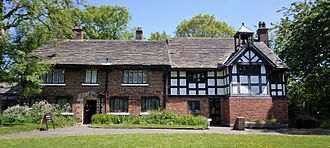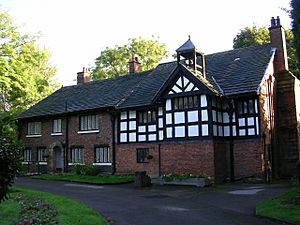Clayton Hall facts for kids
Quick facts for kids Clayton Hall |
|
|---|---|

Clayton Hall in 2023
|
|
| General information | |
| Address | Ashton New Road, Clayton, Manchester, England |
| Coordinates | 53°29′01″N 2°10′46″W / 53.483513°N 2.17945°W |
| Completed | 15th century |
| Renovated | 16th and 17th centuries (altered) 18th century (partly rebuilt/enlarged) c. 1900 and 20th century (restored) |
| Technical details | |
| Floor count | 2 |
| Designations | |
|
Listed Building – Grade II*
|
|
| Official name: Clayton Hall | |
| Designated: | 25 February 1952 |
| Reference #: | 1197795 |
Clayton Hall is a really old house, built way back in the 1400s! You can find it in Clayton, Manchester, tucked away behind some trees in a park. It's a special historical building, protected by law. It even sits on a small hill that's also a protected ancient site. What makes it super cool is that it's surrounded by a moat, like a castle! The moat creates an island about 66 by 74 meters big.
Over the years, especially in the 1500s, 1600s, and 1700s, parts of the hall were changed and made bigger. Today, you can see parts of the building that look like they're from the Tudor times (1485-1603) and Georgian times (1714-1837). These parts are what's left of a much larger building. You cross the moat on an old stone bridge, which is also a protected historical structure. It's thought to be from the late 1600s.
Contents
History of Clayton Hall
The oldest part of Clayton Hall that you can still see was built in the 1400s. It stands on the spot where an even older house, from the 1100s, once stood. This first house belonged to the Clayton family.
From Claytons to Byrons
In 1194, a woman named Cecilia Clayton married Robert de Byron. This is how the hall passed to the Byron family. A famous poet named Lord Byron was a later member of this family. The Byrons lived at Clayton Hall for over 400 years!
The Chetham Family Takes Over
In 1620, the Byron family sold the hall for £4,700 to two brothers, George and Humphrey Chetham. They were merchants from London, but they grew up in Manchester. George Chetham passed away in 1625, and his share of the hall went to his brother Humphrey. Humphrey Chetham himself passed away at the hall in 1653.
After Humphrey, the hall went to his nephew, George Chetham. Humphrey Chetham had a big dream: to create a school and library for everyone. His family used some of his money to start Chetham's School and Library in the center of Manchester. You can see this dream shown in a painting by Ford Madox Brown called Manchester Murals, which is in the Great Hall of Manchester Town Hall.
Later Owners and Changes
George Chetham was a very important person, serving as the High Sheriff in 1660. He passed away in 1664. In 1666, the hall was quite large, with 18 fireplaces! Clayton Hall then passed through several more family members.
From 1863 to 1897, different people rented the hall, including church leaders. In 1897, the hall was sold to the Manchester City Corporation, which is like the city government. They restored the hall around 1900. The oldest part of the hall (from the 1500s) was rented out. The newer part (from the 1700s) had rooms like the dining room and kitchen. The stone bridge over the moat is the oldest structure on the site. It replaced an earlier wooden drawbridge.
Clayton Hall During the Civil War
During the English Civil War, soldiers who supported Parliament stayed at Clayton Hall. This was before they attacked Manchester. Legend says that Oliver Cromwell, a very important leader during the Civil War, even spent three nights there!
Clayton Hall Today: A Living Museum
Today, Clayton Hall is a fantastic place to visit! In 2009, a group of volunteers called the "Friends of Clayton Park" turned the left side of the hall into a hands-on living history museum.
Exploring the Museum Rooms
The volunteers created six rooms that look just like they would have in the late Victorian era. This is the most recent time the hall was owned by a private family. There's also a special room for textiles, filled with old clothes and sewing tools. You can even see antique sewing machines! Another room, called the "memories room," has a huge collection of local and British history items.
Visiting the Hall
The museum is usually open to the public for free on the first and third Saturdays of the month, from February to November. They even offer free history talks about the hall and its past owners at 12 noon and 2 pm.
You can also arrange visits for schools and groups. The hall hosts family events several times a year. Sometimes there's a small fee for these events to help cover costs, but some activities are free.
Supporting Clayton Hall
The money raised from these activities helps to keep the hall preserved for the future. It also helps to make visits even better for everyone. The "Friends" group works closely with Manchester City Council, who still own the hall and its grounds. The council takes care of the building itself.
In 2014, the museum's co-founders created a charity called The Clayton Hall Living History Museum Charitable Incorporated Organisation. This helps them get support and funding.
Newer Sections of the Museum
In 2017, the older, 15th-century part of the hall became part of the museum. This section includes a room on the first floor dedicated to Humphrey Chetham. This was a special request when the hall was sold to Manchester Corporation. There's also a room about the history of Clayton Hall. On the ground floor, you'll find a Tudor tea room, also run by the Friends group. It's open on special days throughout the year. To get to the upper floor, you climb a spiral staircase inside the belltower.
How Clayton Hall Was Built
Clayton Hall was rebuilt in the 1400s. It might have had a square shape with a courtyard in the middle, or perhaps three wings. Most of it was taken down when a new house was built in the 1600s. More parts were added in the 1700s, and the hall was restored around 1900. The hall is made of red brick, with some timber (wood) framing and stone roofs. It's a protected building because of its special architecture.
Older and Newer Parts
The older part of the hall has two sections on the ground floor. It has a simple doorway and windows with two sections. The first floor used to stick out over the ground floor, but that part is now rebuilt in brick. The top floor has three wooden windows with leaded glass. Above the middle window, the roof sticks out, and there's a small bell tower on the roof. This part of the building also has a staircase tower and a large stone chimney.
The newer part of the hall is made of handmade bricks. It has a doorway with a curved stone frame. On either side of the door are pairs of diamond-shaped windows. There are three similar windows of different sizes on the first floor. The drainpipes on the building are dated 1900.
The Moated Site
The area around Clayton Hall is also a protected ancient site because of its moat. The rectangular island, about 66 by 74 meters, is where the original hall stood. This protected area also includes the spot where a chapel (a small church) stood in the late 1300s or early 1400s. That chapel was taken down in the early 1700s.
You can get to the island by crossing a stone bridge with two arches. This bridge replaced an older wooden one. The hall itself, along with its other buildings, fences, and gateposts on the island, are not part of the protected ancient site. The moat, which has been lined with concrete, is also not part of the protected site.
See also
- Grade II* listed buildings in Greater Manchester
- Listed buildings in Manchester-M11


